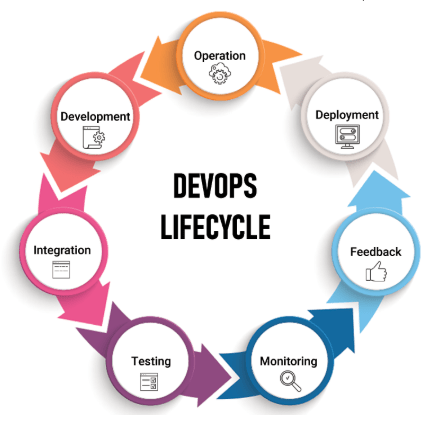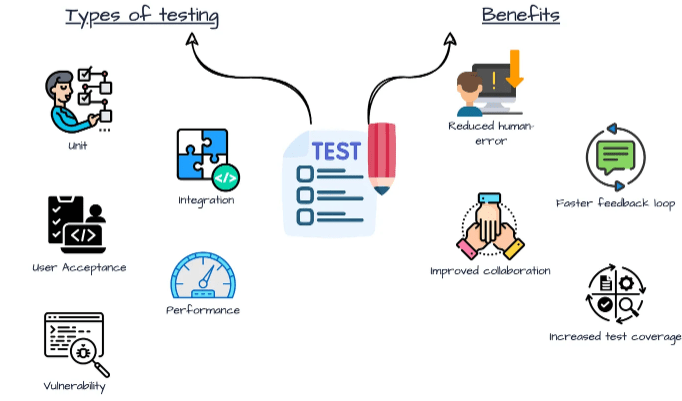
- Introduction to DevOps Testing
- Understanding the DevOps Lifecycle
- Essential Tools for DevOps Implementation
- Different Types of Testing in DevOps
- Popular DevOps Testing Tools and Their Uses
- Conclusion
Introduction to DevOps Testing
DevOps is an integrated/compound machine of improvement and operations. DevOps Testing is a superbly orchestrated collaboration among the Development and Operations groups. Apart from the mainstream components of improvement and operations, the machine of DevOps testing additionally presents different essential elements, which include exceptional engineering and security. Primarily, it smoothens the coordination and collaboration of a few groups. This outcome is within the coaching of higher exceptional products, supported by Devops Training for streamlined development and operations.
Understanding the DevOps Lifecycle
Every enterprise has an extraordinary DevOps lifecycle because it can customize the capability lifecycle. However, the following are the required parts/segments of any given DevOps lifecycle.
The Planning PhaseThe first section/phase of any given DevOps lifecycle is the planning section, where all teams come together to determine an approximate timeline for product development. Key factors such as the tentative release date, potential success rate, product acceptability, and possible controversies are considered to ensure alignment with societal ideologies. The main goal of this phase is to foster transparency among teams and clients, allowing customers to refine their requirements if needed. With The rise of devops , this planning stage has become even more crucial, promoting collaboration, agility, and continuous improvement in software development.
Automation Testing- In easy terms, automation trying out inside the DevOps gear/way of life is deployed to lessen the percentile of human intervention to an exceptional extent. This section consists of verifying the product’s essential capability. The capability check uses automation frameworks alongside DevOps trying out gear. It is available to confirm the general software capability.
- Simply put, automation testing is beneficial for locating bugs, reducing the general human blunders percentile, executing the check instances more than once, and, most importantly, robotically improving the general reliability of the product as well.
- The idea of DevOps trying out gear/way of life and check automation go hand in hand. The advent of the DevOps check automation technique into the DevOps trying out gear/way of life has modified the direction to an exceptional extent. The DevOps automation gear has appreciably altered the QA group’s role.
- Initially, the QA group could wait until the product is perfected before launching it to the public. This could put off the release for numerous days, sometimes for months. With the simultaneous improvement of the product through multiple teams, there could be no such delays.
Excited to Achieve Your AWS Certification? View The Microsoft Azure Course Offered By ACTE Right Now!
Deployment Automation
This section generally follows after checking the capability and electricity of security. In this section, you’ll trial-run the deployment section. This will provide you with information about the usability and readiness of the app to be released to the public. Initially, the deployment trial run was achieved manually. However, with the boom of DevOps testing, deployment automation is developing to an exceptional extent. Currently, deployment may be achieved in public clouds, personal clouds, and additionally on nearby servers. This is available for locations where relatively private statistics are stored, including government agencies.

Essential Tools for DevOps Implementation
Software apps ought to skip through 5 exceptional degrees if they are to be advanced inside a DevOps pipeline:
- Continuous Development
- Continuous Testing
- Continuous Integration
- Continuous Delivery
- Continuous Monitoring
DevOps allows for collaboration among development, operations, and QA. Since many processes are involved, no single tool can be defined as the DevOps tool. Instead, various tools are used across different stages of the DevOps pipeline, which may vary between organizations. Here, we’ve listed some commonly used DevOps tools for each stage. To enhance career opportunities in this field, beginners can refer to a Freshers guide to build a strong devops resume , ensuring they highlight relevant DevOps skills, tools, and experience effectively.
1. Continuous DevelopmentJira software is extensively used for this level within the DevOps pipeline. The software enables collaborations by visually highlighting problems throughout the workflow. The Jira platform is genuinely clean to apply for improvement planning. It additionally allows monitoring daily work and undertaking development reporting.
2. Continuous TestingMany agencies also use Jira to manipulate check cases. This facilitates the operation of each improvement and checking out group together. Zephyr for Jira is a device for creating, executing, monitoring, and reporting check uses.
Excited to Obtaining Your Devops Certificate? View The Devops Training Offered By ACTE Right Now!
3. Continuous IntegrationA CI/CD server called Jenkins can mechanically run checks on every occasion a brand new code is driven into the repository via the means of the developer. CI can locate insects early in the process. This allows the insects to be much less complicated and clean, too. Jenkins was initially made to be a construction automation device for Java. It has become a platform where you can construct, automate, and install any software program. It doesn’t count which laptop language, database, and/or manipulated machine becomes used to write the software program.
4. Continuous DeliveryTools like Puppet or Chef allow customers to avoid *snowflake servers* in their delivery/deployment environment. Snowflake servers are manufacturing servers that have been running for a long time and have undergone multiple configurations and changes, making them unique—hence the name. These servers require manual configuration beyond automated deployment scripts. Using manifests in Puppet or recipes in Chef, users can define the configuration of a server’s components, enabling automated and consistent environment setup. For those looking to enhance their expertise in handling complex cloud environments, Mastering Snowflake development can provide valuable insights into managing scalable and automated data solutions.
5. Continuous MonitoringLog tracking tools like Splunk and ELK assist customers in examining statistics on all transactions that have taken place near their deployed IT applications. This ensures consistent performance, security, availability, and user experience. Both of these tools provide a scalable way of collecting and indexing log files. They also offer customers the ability to interact with data and create visualizations like dashboards, alerts, or reports, enhancing monitoring and troubleshooting through Devops Training .
Different Types of Testing in DevOps
There are numerous kinds of DevOps. Let’s take a look and observe them one by one.
- Chain Test: The chain test facilitates verifying that each app in the chain is running properly together. This is occasionally additionally known as the integration test.
- Component Test:Oversized packages are built with various components, and component testing examines them. Key artifacts in devops like build scripts, configs, and deployment manifests ensure smooth integration and deployment.
- Functional Acceptance Test: This review facilitates confirming if the app’s good direction is in step with the practical requirements. The mistakes and trade paths need to be examined as well.
- Integration Test: It works just like the component test; however, while the component test works on one factor at a time, this will work on more than one additive simultaneously.
- Performance Stress Test: This looks at assessments of whether the gadget can deal with the request on time through a fixed variety of users, historical past workload, and transactions.
- Production Acceptance Test: This look verifies if the app can paint first-class within the goal environment.
- System Test: This takes a look at verifying whether the app can satisfy the requirements.
- Unit Test: This takes a look at and examines a small, unmarried object.
- User Acceptance Test: User Acceptance: This step examines facilitates to determine whether the consumer can use the app and whether it’s consumer-friendly, effortless, usable, etc.
- Unit checks are the primary checks completed inside the Automated Devops pipeline . They are written as a part of the Test-Driven Development (TDD) process. The unit checks that every code piece is written before the code itself. TDD is a critical part of the agile approach and allows builders to be thorough about how every unit of the software program they’re constructing must behave.
- JUnit is a device utilized by Java developers to create repeatable instances, which assists in increasing programming speed and improving code quality. The device provides diverse capabilities, such as review suites, fixtures, review runners, and JUnit classes.
Many DevOps groups additionally rent Acceptance Test-Driven Development (ATTD) and Behavior-Driven Development (BDD) to run more excellent superior checks. This permits trying to be completed repeatedly in mild increments while software program additives are assembled on each other. - A BDD device called Cucumber inspires collaboration among QA, builders, and commercial enterprise participants. It allows bridging the distance between IT and commercial enterprise via writing to look at instances in a language that area specialists and non-programmers can read.
Interested in Pursuing a Devops Master’s Program? Enroll For Devops Master Course Today!

Popular DevOps Testing Tools and Their Uses
Using DevOps Testing Tools allows DevOps groups to work in diverse ways, for example, by enhancing the code satisfaction of the team, accelerating the software program’s time to marketplace inside the DevOps pipeline, and offering non-stop brief comments to growth collaboration among all of the groups involved. Let’s examine a number of them:
Preparing for Your Devops Interview? Check Out Our Blog on Devops Interview Questions & Answer
Conclusion
With the plentiful boom of DevOps testing, picking the proper testing method has become vital to ensure organizational success. Furthermore, with the effect of DevOps on diverse components of organizational functionalities, it’s critical to ensure that the system has the right impact on teams without overstepping any boundaries. This will ensure that the applied DevOps culture aligns with the core principles of the DevOps framework. Additionally, continuous monitoring and feedback loops help refine testing strategies for better efficiency. Implementing the right DevOps testing approach leads to faster releases, improved collaboration, and enhanced software quality with the help of Devops Training .





